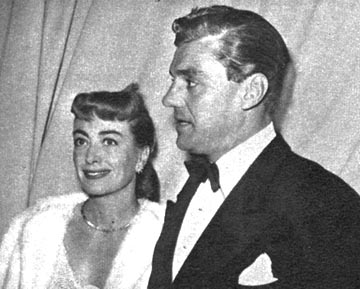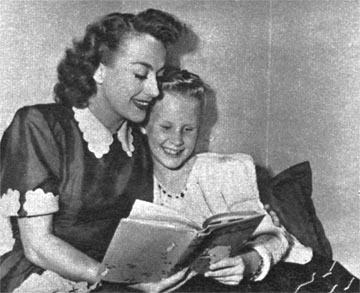What's She Really Like?
That's the question most frequently asked anyone who knows a movie star. In a penetrating new series, Motion Picture answers that query frankly and honestly. First to get the full treatment is Joan Crawford.
by John
Maynard
Originally appeared
in Motion Picture, April 1949
One evening recently in the suede-walled den and bar that is perhaps the coziest of all the rooms in Joan Crawford's Brentwood home, we sat discussing life and people in general.
She wore a blue hostess gown with remarkable square shoulders that tended to make her look taller than her unexceptional five-feet-four. Her face was composed but not relaxed; skin drawn rather tight over high cheek bones, the familiar concave lines from the eye-sockets downward and a chronic vertical furrow between the brows gave her an air of tension even in repose. She knitted furiously and abstractedly.
 |
| Joan's romance with lawyer Greg Bautzer is unpredictable but he loves her children and they adore him. |
Her two oldest adopted children, Christina and Christopher, were in the room, with the result that she kept her voice low much of the time. They are blonde, wonderfully mannered, respectively lovely and handsome, and utterly charming -- an eloquent testimony to a very fine mother. She made no effort to shoo them out and checked herself at intervals to explain the mysteries of a picture magazine to Christopher or urge Christina to go on with a knitting job of her own. Christina was slackening up periodically with every indication of ears beginning to flap to catch the drift of the coversation. This was unwise because the drift of the conversation around about then devolved to the point of whether Miss Crawford had or had not obtained her children by black market means. It seems that some reporter had asked that very stupid question that very day.
The answer to this oddly-insulting query is that the children were obtained though the most valid adoption imaginable.
"What," she asked, now intensifying the furrow above her nose a trifle, "do you say to a question like that? It's loaded -- it's not fair. I think everyone knows that I adore most of the members of the press. Some of them are my best friends and, on the whole, I think we get along fine, but I suppose in any group of wonderful people you are apt to meet one or two who are not quite so wonderful."
Which should certainly not reflect on the legitimate reports and editors.
There was a pause while Christina was admonished to pick up her pace a little.
"It's not that I insist on a Little Orphan Annie press. Anybody who knows me at all knows I don't. How could I, even? All of have done things we would rather not see in print and I have made all my mistakes in public because I grew up publicly."
That, again as a matter of record, may well be so. Joan Lucille LeSueur Cassin Fairbanks Tone Terry Crawford has been written of at various times as (a) hoydenish, (b) unlettered, (c) awkward, (d) shy, (e) ruthless, (f) every inch the Movie Star, (g) every inch the Poised Woman of the World and (h) one of the nicest persons in Hollywood.
The interesting thing about these near-cliches is that taken in chronological order they likely are the truth. the last two almost certainly are.
They bear on the present, however, only as the phases of a hard-won evolution that finally has settled into a wondrous symmetry of manner, social grace and way of life.
Joan Crawford's closest friends and professional associates also contend that through her home and children she has at last found something approximating peace of mind.
The evidence assuredly is that she has.
The relaxed, domestic life she shares with her youngsters -- the two little girls, Cathy and Cynthia, are twins resembling animated, purposeful apples -- is a model of the American dream without assuming the baleful, saccharine pose of commercial advertising. Although no report, including this one, is authorized to soothsay her love life, it is generally supposed in Hollywood that she is in love with a personable Los Angeles lawyer named Gregson Bautzer who adores and is adored by the children.
Her career is in the full flush of an astonishing renaissance after a period of doldrums she herself refers to as "three years of sitting at the not-so-good tables in restaurants -- Hollywood headwaiters have ears like the well-known lynx."
If courage and integrity can be said by rote to pay off, then Joan Crawford has earned what she has. Some days were not happy. The story of her twenty-two year rise from rags to riches is too well-known to repeat here at any length. She made it the hard way. Neither press nor gossip was always kind to her. One of her most distressing experiences, for example, occurred a number of years ago. She was dressing for a theater opening one night when she heard her name being shouted on the street by a newsboy. She sent her maid out for a paper. The headlines read, "Joan Crawford Named in Alienation of Affections Suit."
 |
| Daughter Christina is oldest of her four adopted children. There are twin daughters and a young son. |
The truth of the matter was that she had taken three lessons from the man but he was using her as an excuse to be away from home.
"I didn't know what to do," Joan said. "I had visions of arriving at the premiere and having people throw rotten tomatoes at me. I finally decided that I had done nothing wrong and would go to the opening anyway. I went and, of course, nothing happened."
She admits that the incident gave her a few bad dreams but is now convinced that unfair gossip is something that one in the public eye must endure. That is an instance of a major dis-service perpetrated on her by public babble (the face is tense, the vertical furrow fixed).
Among minor ones might be said to be the appellation, every inch the Movie Star. That is not fair to her. She is not every inch the movie star except in the sense that she dresses to go out in rather spectacularly good taste. Every inch the Movie Star conveys, as a phrase, an impression of spurious graciousness, the kind of condescension that makes some stars -- emphatically not Miss Crawford -- greet the layman, or common man, with an effusiveness that is downright embarrassing. They seem scarcely less glad to see you than your own mother and the only conclusion to be drawn it is an inverse manifestation of snobbery.
Joan Crawford is direct, actually forthright and relaxed -- that is all. The classic caricatures of her -- both written and drawn -- are dated. In the first, she receives parties of not less than 722 guests in queenly fashion, presiding over a staggering mansion in a manner befitting rank, and underscoring her diction excessively. The second confines itself to two wide, coal-darkened eyes and a super-imposed blob of sullen mouth.
Neither is worth a hoot from the point of information. Her eyes naturally are still wide and slightly protuberant -- nothing can be done about that -- but they are now made up to minimize the staring effect, and are barely noticeable as a facial characteristic. The pain-of-it-all mouth has long ago disappeared. Her use of lipstick is nearly ascetic; her own mouth is unobtrusive, mobile, thinnish. Her hair is reddish-brown, worn now drawn back tightly along the sides of the head and terminating in a bun which may or may not be directly related to the scalp. She uses a cigarette-holder, true, but purely for the reason many person do -- she prefers the smoke diluted. And it is a brief, modest affair.
The house is not a mansion, and the big parties come off now not much more than annually. Twenty-seven rooms may seem by definition a mansion, but that is, of course, counting hallways, bathrooms, dressing rooms, servant's quarters, but so gracefully has the home been constructed -- wing by wing, room by room, year by year -- that it becomes practically diffident in relation to its size. It had been beautifully decorated -- expert William Haines -- but with the eye strictly averted from ostentation.
It's been said of Miss Crawford that the home is the first love of her life. Bearing the children in mind, that, too, constitutes an affront. To the extent that she suffers nervous agonies if anyone drops a burning cigarette on a rug and spends hours scrubbing the floors herself, there can be no doubt that it may stand third or even second. But it is just as certain she would scrap the whole kaboodle to save one of the youngsters the slightest injury.
She is a woman driven by a great deal of taut energy. While working she gets up at 5:30 a.m., if not, at 6:30. On these loafing days, she gets the children fed and underway, whatever they may be doing, then plows into the housework, then into the mail, then into shopping. She an industrious, almost fanatic shopper. Then whatever the evening may hold, but very little yippee any more. Badminton and some tennis occupy her from time to time, and she swims -- very well -- in a neat but not gaudy pool of her own.
A few weeks ago she was forced, by circumstances entirely beyond her control, to stand up an interviewer. The first was no stranger to stand-ups but could not conceive of Miss Crawford being the guilty party. Speaking as an old friend of the lady, he assured the interviewer that Miss Crawford was temperamentally incapable of such breach and there must be a good reason for the lapse.
There was. Miss Crawford called the interviewer, whom she had never met, the next morning, apologized abjectly, invited him to lunch and concluded by doing what she definitely did not have to do -- explaining the wherefore of her action. The last involved a somewhat tricky situation that has no place here but that concerned an individual close to Miss Crawford's personal life.
The publicity in point, so far as Miss Crawford could guess, was dead. She didn't need it anyway. It was all wholly a gesture of pure decency by a thoroughly decent woman. In Hollywood or elsewhere, they do not come much nicer.
WEBMISTRESS'S NOTE: Four color pictures accompanied this article. They can be seen on the 1949 Images page, one in the Flamingo Road section (Joan with David Brian), three in the Misc. section.